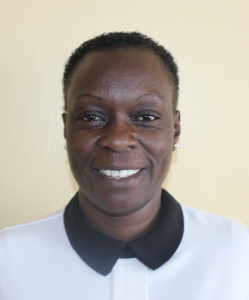There is no source of water on the grounds of St. Lucia Irobo Primary School. So, students have to leave class to find the water they need.
They go to a spring in the community that’s about a 700-meter walk one way. There is plenty of good water at this spring, but the students’ walk and hard work to fetch enough water for drinking and cleaning is the real issue.
After carrying such a heavy container of water, students return to class too exhausted and distracted to study.
"Our pupils go a long distance to get water from the unprotected spring. This affects their study time because a lot of time is spend fetching water," explained the teacher in charge of sanitation at the school, Mr. George Mulama.
Beyond the students' burden of carrying water, the support staff is also required to fetch water throughout the day.
St. Lucia Irobo Primary School was established in 1971. The school hosts pupils who come from very humble backgrounds. Some of them live with their grandparents, while others are orphans. The school has been on and off due to poor enrollment. The school has stabilized and now has a high enrollment of 717 students.
The school is in rural area where and is not easily reached. It has 17 classrooms from early education through primary. There are at least 84 pupils per class, making the rooms very overcrowded.
The headteacher wrote a request letter asking that the school be considered for construction of a water tank and toilets. He made a follow-up visit to the offices, too. We arranged for a visit to assess the need for ourselves, and found that the hygiene and sanitation situation at the school is very bad.
What we can do:
Training
Training on good hygiene habits will be held for two days. The facilitator will use PHAST (participatory hygiene and sanitation transformation), ABCD (asset-based community development), CTC (child to child), lectures, group discussions, and handouts to teach health topics and ways to promote good practices within the school. The CTC method will prepare students to lead other students into healthy habits, as well as kickstart a CTC club for the school.
Handwashing Stations
This CTC club will oversee the new facilities, such as handwashing stations, and make sure they are kept clean and in working condition. The two handwashing stations will be delivered to the school, and the club will fill them with water on a daily basis and make sure there is always a cleaning agent such as soap or ash.
VIP Latrines
The toilet facilities are not enough for the pupils, with only 10 latrines total. These are in very bad condition and the pits are almost full. Many pupils also use the latrine with bare feet, exposing themselves to a myriad of germs because the latrines are not washed with water throughout the day.
Two triple-door latrines will be constructed with local materials that the school will help gather. Three doors will serve the girls while the other three serve the boys. And with a new source of water on school grounds, students and staff should have enough to keep these new latrines clean.
Rainwater Catchment Tank
A 50,000-liter rainwater catchment tank will help alleviate the water crisis at this school. The school will also help gather the needed materials such as sand, rocks, and water from the spring for mixing cement. Once finished, this tank can begin catching rainfall that will be used by the school’s students and staff.
We and the school strongly believe that with this assistance, standards will significantly improve. These higher standards will translate to better academic performance!

 Rainwater Catchment
Rainwater Catchment
 Rehabilitation Project
Rehabilitation Project

































